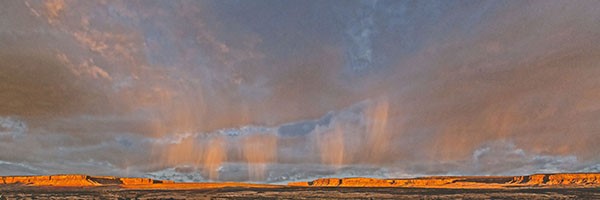
| |
Why come to remember in this place, an isolated rock promontory on Cedar Mesa, 1,500 feet above the eroded sandstone mesas and pinnacles of Valley of the Gods? We were both academics, citizens of a world of scientists, moving with ease among collaborators in Japan, Europe, Latin America, and the U.S. Connected as we were with colleagues throughout the world and as peripatetic as our lives could be, there was no place, no land that we could call our true home. With one exception: the red rock country of southeastern Utah. Neither of us were Westerners: I was born in New York City and Karen in eastern Oklahoma. We made our first visits to the Colorado Plateau in our early forties, when we began to explore landscapes of the Navajo Nation. Drawn to both the country and its people, we decided to offer our services to teach a few classes at Navajo Community College (now Diné College) in Tsaile, Arizona, during the summers of 1981 and 1982. We soon developed relationships not only with the land, but with a web of Native writers, poets, sculptors, and painters. Our scientific careers led us eastward to Amherst, Massachusetts, which was our base for 14 years. But throughout those years we were drawn to return to land we thought of as home: camping and hiking in southeastern and south-central Utah, capturing the landscape's chromatic and sculptural rhythms in photographs and later joining those images with the work of Native poets Joy Harjo and Laura Tohe. We also invited our children and grandchildren to join us in exploring the slickrock, hogbacks, hoodoos, rivers, and canyon labyrinths of what was slowly becoming "home." They came, and some learned to love the land as we did. One is the essayist for this book and the author of its companion: Voices from Bears Ears Country: Seeking Common Ground on Sacred Land. Rebecca: who hiked to White House Ruins in Canyon de Chelly at the age of 4 and on a hot summer day in 1988 immersed her feet in the sands and waters of Chinle Creek—a baptism celebrating her joining the congregation of redrock worshippers. Today, on Muley Point, she, a quarter-century older, stood nearby me, as we gathered our thoughts in silence—the majesty of the land compels no less. And in that silence she, too, I imagined, felt the power of this place, the sun, the sky, the rock, the San Juan River nearby. This promontory and the Colorado Plateau on which it stands, has borne witness to many changes: to the shift of tectonic plates that carried it on a journey of more than a billion years, starting from near the equator to where it stands today, some 5,000 miles to the north; to the uplift, which raised the Plateau from sea level to more than a mile above the oceans; to the arrival of megafauna and then man; to the rise of agricultural and then urban civilizations; to the coming of the Spanish and Mormons; to a gathering to remember the life of a scientist, mother, grandmother, colleague, mentor, muse, and companion. Such is the wonder and grandeur and solace to be shared in such a place.
|
